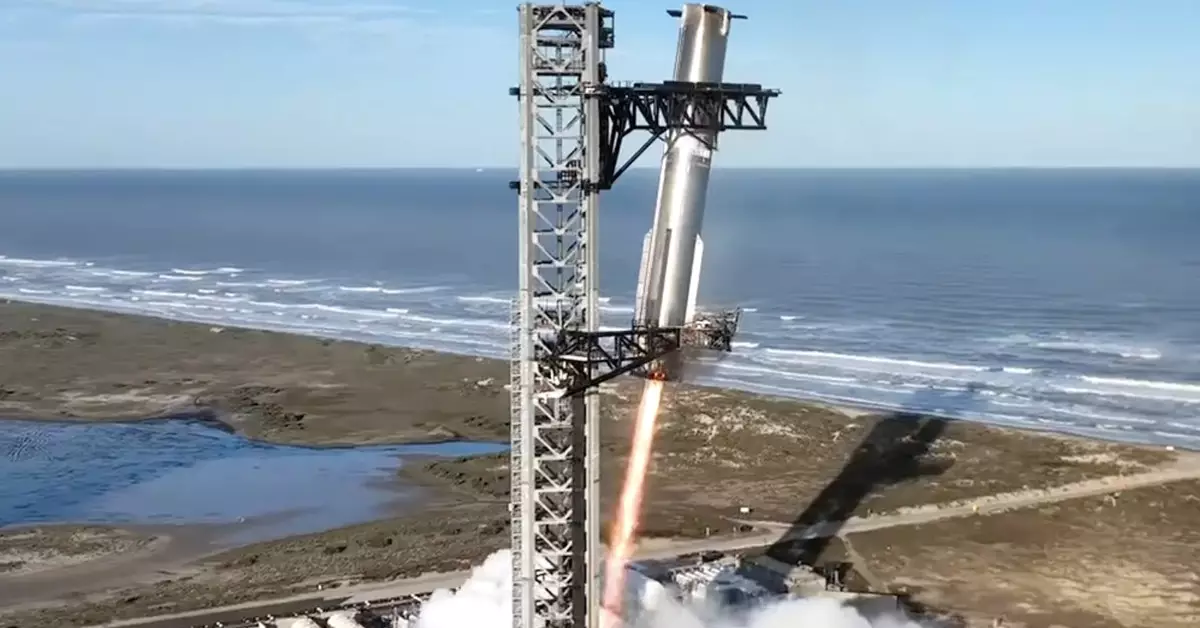SpaceX has once again captured the imagination of space enthusiasts and technologists alike. The recent Starship test flight marked a significant milestone for the aerospace company, showcasing impressive attempts at proving both the reusability of its launch systems and the operational reliability of its ambitious Starship program. However, this test also highlighted the persistent challenges and unpredictability associated with cutting-edge space exploration.
During the seventh test flight originating from Boca Chica, Texas, SpaceX successfully caught its Super Heavy booster with the aid of the launch tower’s gripping mechanism, affectionately known as the “chopsticks.” This achievement is particularly noteworthy, as it represents a crucial element of SpaceX’s vision for reusability, which aims to reduce costs and increase the frequency of launches. The technical prowess involved in catching a vertical rocket booster after launch is unprecedented, positioning SpaceX as a pioneer in the aerospace domain.
However, while the catching of the booster might have been deemed a success, the journey of the Starship spacecraft itself took a troubling turn. Within moments of its ascent, communication was lost, leading SpaceX engineers to conclude that the spacecraft had likely been destroyed. Such challenges exemplify the inherent risks associated with spaceflight, where even small malfunctions can have drastic consequences.
Kate Tice, a representative from SpaceX, provided insight into the mishap, revealing that several of the Raptor engines on the Starship dropped during ascent. The phrase “rapid unscheduled disassembly” was used to describe the spacecraft’s sudden failure, suggesting a catastrophic event that resulted in the loss of the vehicle. This terminology serves as both a technical label and a stark reminder of how unpredictable space missions can be, even after extensive preparation and improvements.
The data regarding the flight is currently being analyzed in detail by SpaceX teams, as they strive to discern the precise causes of the failures. Much has been made about the enhancements applied to this version of the Starship, including a new propulsion system and an upgraded heat shield featuring various metallic tiles. Yet, despite these innovations, the unfortunate outcome highlights that advancements in technology do not automatically guarantee flawless execution.
Interestingly, reports emerged from the tourists in the Turks and Caicos Islands, who claimed to have witnessed the debris from the Starship’s descent. Video footage was shared on social media, proving that even from hundreds of miles away, people were captivated by the drama unfolding in the skies. Such events not only spark public interest but also fuel discussion about the implications of space debris and the need for sustainable practices in space exploration.
Additionally, one of the critical objectives for this test flight was to deploy Starlink “simulators.” While the mock satellites, designed to match the specifications of the actual Starlink units, were intended to float briefly in space, the communication loss renders this goal unattainable. This setback marks yet another hurdle in the journey toward enhancing global internet connectivity through satellite technology.
The Future of Starship
Despite the challenges encountered, the trajectory for the Starship program remains optimistic. The reuse of the Super Heavy’s Raptor engines from previous flights demonstrates a forward-thinking approach by SpaceX, signaling their commitment to iterating on and refining their technology. At a groundbreaking height of 403 feet, the Starship system stands as the tallest launch vehicle ever constructed, underscoring the ambition encapsulated within this project.
Both the Starship spacecraft and its Super Heavy booster are designed with sustainability in mind, emphasizing the burgeoning focus within the aerospace industry on reusable systems. This aligns with broader trends in technology where innovation often intertwines with ecological considerations, a movement SpaceX is keen to champion.
As SpaceX continues to evaluate what went wrong during the latest test, the surrounding community will undoubtedly maintain its keen interest in the findings and subsequent developments. The complexities of space exploration mean that setbacks are fundamentally part of the learning curve, and SpaceX’s relentless pursuit to conquer the cosmos reflects a valuable lesson in resilience and innovation.

